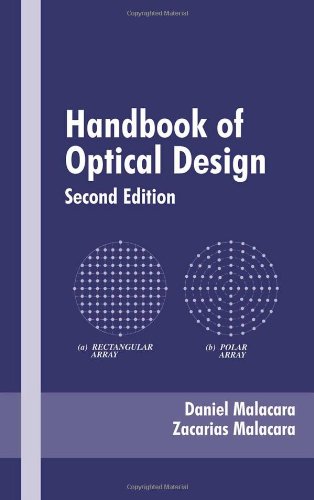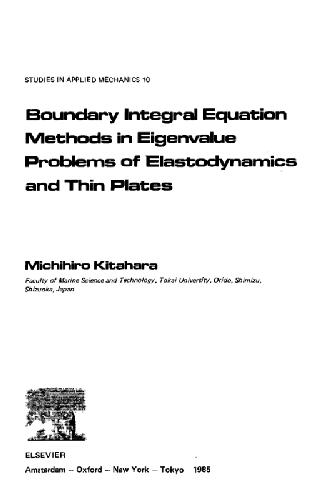Daniel Malacara, Zacarias Malacara0-8247-4613-9, 9780824746131
Table of contents :
Handbook of Optical Design Second Edition……Page 1
Preface to the Second Edition……Page 7
Preface to the First Edition……Page 8
Contents……Page 10
A1.1 NOTATION……Page 16
A1.2.1 Conrady’s Form……Page 19
A1.2.2 For Numerical Calculation……Page 20
A2.1 SPHERICAL AND ASPHERICAL SURFACES……Page 23
A2.1.1 Aberrations of Normals to Aspheric Surface……Page 26
A2.1.3 Off-Axis Paraboloids……Page 28
A2.1.4 Toroidal and Spherocylindrical Surfaces……Page 30
REFERENCES……Page 32
A3.1 OPTICAL GLASSES……Page 34
A3.3 INFRARED AND ULTRAVIOLET MATERIALS……Page 37
BIBLIOGRAPHY……Page 38
A4.1.1 Transfer from First Surface to Plane Tangent to Next Surface……Page 39
A4.1.2 Transfer from Tangent Plane to Osculating Sphere……Page 40
A4.1.3 Transfer from Osculating Sphere to Aspheric Surface……Page 44
A4.1.4 Refraction at Aspheric Surface……Page 47
A4.1.5 Refraction at Toroidal or Spherocylindrical Surfaces……Page 48
A4.2 SUMMARY OF RAY TRACING RESULTS……Page 49
A4.3 TRACING THROUGH TILTED OR DECENTERED OPTICAL SURFACES……Page 51
REFERENCES……Page 54
Books……Page 56
Review Articles or Chapters in Books……Page 57
1.1 WAVE NATURE OF LIGHT AND FERMAT’S PRINCIPLE……Page 58
1.1.1 Gradient Index of Refraction……Page 64
1.2.1 Reflection Laws……Page 66
1.2.2 Refraction Laws……Page 67
1.2.3 Vectorial Form of Refraction Laws……Page 68
1.3 BASIC MERIDIONAL RAY TRACING EQUATIONS……Page 69
1.3.1 Meridional Ray Tracing by the L–U Method……Page 73
1.3.2 Meridional Ray Tracing by the Q–U Method……Page 74
1.4 GAUSSIAN OR FIRST-ORDER OPTICS……Page 75
1.4.2 Delano’s Relation……Page 78
1.5 IMAGE FORMATION……Page 79
1.6 STOP, PUPILS, AND PRINCIPAL RAY……Page 82
1.6.1 Telecentric Systems……Page 85
1.7 OPTICAL SINE THEOREM……Page 86
1.7.1 Lagrange Invariant……Page 88
1.8 HERSCHEL INVARIANT AND IMAGE MAGNIFICATIONS……Page 90
1.9 RAY ABERRATIONS AND WAVE ABERRATIONS……Page 91
REFERENCES……Page 93
2.1 THIN LENSES……Page 95
2.2 FORMULAS FOR IMAGE FORMATION WITH THIN LENSES……Page 98
2.3 NODAL POINTS OF A THIN LENS……Page 100
2.4 IMAGE FORMATION WITH CONVERGENT LENSES……Page 101
REFERENCES……Page 103
3.1 FOCAL LENGTH AND POWER OF A LENS SYSTEM……Page 104
3.2 IMAGE FORMATION WITH THICK LENSES OR SYSTEMS OF LENSES……Page 106
3.3 CARDINAL POINTS……Page 108
3.4 IMAGE FORMATION WITH A TILTED OR CURVED OBJECT……Page 110
3.5 THICK LENSES……Page 112
3.6 SYSTEMS OF THIN LENSES……Page 115
3.7 THE LAGRANGE INVARIANT IN A SYSTEM OF THIN LENSES……Page 118
3.8.1 Shifting the Stop……Page 119
3.8.2 Shifting Object and Image Planes……Page 121
3.9 THE DELANO y–y DIAGRAM……Page 122
A Shift of the Object and Image……Page 126
REFERENCES……Page 127
4.1 SPHERICAL ABERRATION CALCULATION……Page 128
4.2 PRIMARY SPHERICAL ABERRATION……Page 132
4.2.1 Spherical Aberration of a Thin Lens……Page 135
4.2.3 Spherical Aberration for a Plane-Parallel Plate in Converging Light……Page 139
4.4 SPHERICAL ABERRATION OF ASPHERICAL SURFACES……Page 141
4.5.1 Refractive Spherical Surfaces……Page 142
4.5.3 Descartes Ovoid……Page 144
4.6 ABERRATION POLYNOMIAL FOR SPHERICAL ABERRATION……Page 146
4.6.1 Caustic……Page 148
4.6.2 Aberration Balancing……Page 151
4.7 HIGH-ORDER SPHERICAL ABERRATION……Page 153
4.8 SPHERICAL ABERRATION CORRECTION WITH GRADIENT INDEX……Page 154
REFERENCES……Page 156
5.1 OBLIQUE RAYS……Page 157
5.2 PETZVAL CURVATURE……Page 163
5.3.1 Offense Against the Sine Condition……Page 166
5.3.2 Coma Contribution of Each Surface……Page 168
5.4 ASTIGMATISM……Page 170
Tangential Image……Page 173
Sagittal Image……Page 174
5.4.2 Relations Between Petzval Curvature and Astigmatism……Page 175
5.4.3 Comatic and Astigmatic Images……Page 177
5.4.4 Aplanatic Refractive Surfaces……Page 182
5.5 DISTORTION……Page 183
5.6 OFF-AXIS ABERRATIONS IN ASPHERICAL SURFACES……Page 186
5.7 ABERRATIONS AND WAVEFRONT DEFORMATIONS……Page 189
5.8 SYMMETRICAL PRINCIPLE……Page 192
5.9 STOP SHIFT EQUATIONS……Page 193
REFERENCES……Page 196
6.1 INTRODUCTION……Page 198
6.2 AXIAL CHROMATIC ABERRATION……Page 199
6.2.1 Axial Chromatic Aberration of a Thin Lens……Page 201
6.2.2 Achromatic Doublet……Page 202
6.2.3 Achromatic Doublet with Separated Elements……Page 204
6.2.4 Axial Chromatic Aberration Correction with One Glass……Page 205
6.2.5 Spherochromatism……Page 208
6.2.6 Conrady’s D–d Method of Achromatization……Page 209
6.3 SECONDARY COLOR ABERRATION……Page 211
6.3.1 Apochromatic Triplet……Page 212
6.4 MAGNIFICATION CHROMATIC ABERRATION……Page 213
6.4.2 Correction of the Magnification Chromatic Aberration……Page 216
6.4.3 Magnification Chromatic Aberration Correction with One Glass……Page 218
REFERENCES……Page 221
8.1 HUYGENS–FRESNEL THEORY……Page 244
8.2 FRESNEL DIFFRACTION……Page 245
8.3 FRAUNHOFER DIFFRACTION……Page 248
8.3.1 Circular Aperture……Page 251
8.3.2 Annular Aperture……Page 252
8.4 DIFFRACTION IMAGES WITH ABERRATIONS……Page 253
8.5 STREHL RATIO……Page 255
8.6 OPTICAL TRANSFER FUNCTION……Page 257
8.6.1 Optical Transfer Function and Strehl Ratio……Page 261
8.7 RESOLUTION CRITERIA……Page 262
8.8 GAUSSIAN BEAMS……Page 264
8.8.1 Focusing and Collimating a Gaussian Beam……Page 266
REFERENCES……Page 267
9.1 MERIDIONAL RAY TRACING AND STOP POSITION ANALYSIS……Page 269
9.2.1 Geometrical Spot Size……Page 271
9.3.1 Calculation from Transverse Aberrations Data……Page 276
9.3.2 Direct Calculation of the Optical Path……Page 277
9.3.3 Conrady’s Method to Compute Wavefront Deformation……Page 280
9.4 POINT AND LINE SPREAD FUNCTION……Page 282
9.5.1 Geometrical Optical Transfer Function……Page 284
9.6 TOLERANCE TO ABERRATIONS……Page 286
9.6.1 Curvature and Thickness Tolerances……Page 287
REFERENCES……Page 288
10.2 DEFLECTING A LIGHT BEAM……Page 290
10.3 TRANSFORMING AN IMAGE……Page 293
10.4.1 Deflecting Prisms……Page 295
10.4.2 Retroreflecting Systems……Page 296
10.5.1 Inverting and Reverting Prisms……Page 299
10.5.2 Rotating Prisms……Page 300
10.6 BEAM-SPLITTING PRISMS……Page 302
10.7 CHROMATIC DISPERSING PRISMS……Page 304
REFERENCES……Page 308
11.1 OPTICAL SYSTEMS DIVERSITY……Page 309
11.2.1 Magnifiers……Page 310
11.2.2 Biocular Magnifiers……Page 313
11.2.3 Single Imaging Lens……Page 315
11.2.4 Landscape Lenses……Page 318
11.3 SPHERICAL AND PARABOLOIDAL MIRRORS……Page 320
Spherical Aberration……Page 322
Spherical aberration……Page 323
Astigmatism……Page 324
Petzval Curvature……Page 325
Spherical Aberration……Page 326
Coma……Page 327
Astigmatism……Page 328
11.3.4 Convex Spherical Mirror……Page 329
11.4 PERISCOPIC LENS……Page 331
11.5 ACHROMATIC LANDSCAPE LENSES……Page 333
11.6 ACHROMATIC DOUBLE LENS……Page 334
11.7.1 Mangin Mirror……Page 335
11.7.2 Dyson System……Page 336
11.7.3 Offner System……Page 337
11.8 FRESNEL LENSES AND GABOR PLATES……Page 338
REFERENCES……Page 340
12.1 INTRODUCTION……Page 341
12.2.1 Petzval Lens……Page 342
12.2.3 Cooke Triplet……Page 344
12.2.4 Tessar Lens……Page 350
12.3 SYMMETRICAL ANASTIGMAT SYSTEMS……Page 351
12.3.1 Dagor Lens……Page 352
12.3.2 Double Gauss Lens……Page 353
12.4 VARIFOCAL AND ZOOM LENSES……Page 356
REFERENCES……Page 362
13.1 THE HUMAN EYE……Page 364
13.1.1 Eye Aberrations……Page 366
13.2 OPHTHALMIC LENSES……Page 367
13.2.1 Ophthalmic Lens Magnifying Power……Page 370
13.3 OPHTHALMIC LENS DESIGN……Page 371
13.3.1 Tscherning Ellipses……Page 374
13.3.2 Aspheric Ophthalmic Lenses……Page 375
13.4 PRISMATIC LENSES……Page 377
13.5 SPHEROCYLINDRICAL LENSES……Page 378
REFERENCES……Page 380
14.1.1 Diffraction Effects and Atmospheric Turbulence……Page 382
14.1.2 Visual Limit Magnitude of a Telescope……Page 383
14.1.3 Photographic and CCD Limit Magnitude of a Telescope……Page 384
14.2.1 Schmidt Camera……Page 386
14.2.2 Bouwers Camera……Page 388
14.3 NEWTON TELESCOPE……Page 390
14.4.1 First-Order Design of Two Mirror Telescopes……Page 391
Spherical Aberration……Page 395
Coma……Page 396
Astigmatism……Page 397
14.4.3 Ritchey–Chretien Telescope……Page 398
14.4.4 Dall–Kirham Telescope……Page 403
14.4.5 Gregory Telescope……Page 404
14.4.6 Coude´ and Nasmythe Focus Configurations……Page 405
14.5 FIELD CORRECTORS……Page 406
14.5.2 Ross Corrector……Page 407
14.5.3 Wynne Corrector……Page 409
14.5.4 Aspheric Correctors……Page 410
14.6.1 Anastigmatic Concentric Schmidt–Cassegrain Telescope……Page 411
14.6.2 Flat-Field Anastigmatic Schmidt–Cassegrain Telescopes……Page 412
Spherical Secondary……Page 413
14.7 MULTIPLE MIRROR TELESCOPES……Page 414
14.8 ACTIVE AND ADAPTIVE OPTICS……Page 416
REFERENCES……Page 418
15.1.1 Exit Pupil Location in Visual Optical Systems……Page 421
15.1.2 Optical Models of the Human Eye……Page 423
15.2 BASIC TELESCOPIC SYSTEM……Page 424
15.3 AFOCAL SYSTEMS……Page 427
15.3.1 Two-Mirror Afocal Systems……Page 429
15.4 REFRACTING OBJECTIVES……Page 430
15.4.1 NonAplanatic Doublet……Page 431
15.4.2 Broken Contact Doublet……Page 435
15.4.3 Parallel Air-Space Doublet……Page 438
15.4.6 Laser Light Collimators……Page 439
15.5 VISUAL AND TERRESTRIAL TELESCOPES……Page 441
15.5.1 Galilean Telescopes……Page 442
15.5.2 Design of a Terrestrial Telescope Objective……Page 445
15.6 TELESCOPE EYEPIECES……Page 446
15.6.1 Huygens and Ramsden Eyepieces……Page 448
15.6.2 Erecting Eyepiece……Page 450
15.6.5 Orthoscopic Eyepiece……Page 451
15.6.6 Erfle Eyepiece……Page 453
15.7 RELAYS AND PERISCOPES……Page 455
15.7.1 Indirect Ophthalmoscope……Page 456
15.7.2 Endoscopes……Page 458
REFERENCES……Page 460
16.1 COMPOUND MICROSCOPE……Page 462
16.1.1 Microscope Aperture and Resolving Power……Page 465
16.2 MICROSCOPE OBJECTIVES……Page 468
16.2.2 Lister Objectives……Page 472
16.2.3 Amici Objectives……Page 473
16.2.4 Oil Immersion Objectives……Page 474
16.2.6 Reflecting Objectives……Page 475
16.3 MICROSCOPE EYEPIECES……Page 477
16.3.1 Huygens Eyepieces……Page 478
16.3.2 Wide-Field Eyepieces……Page 480
16.4 MICROSCOPE ILLUMINATORS……Page 481
REFERENCES……Page 484
17.1 SLIDE AND MOVIE PROJECTORS……Page 486
17.2 COHERENCE EFFECTS IN PROJECTORS……Page 487
17.3.1 Lamp……Page 488
17.3.2 Condenser……Page 489
17.3.3 Projecting Lens……Page 490
17.4 ANAMORPHIC PROJECTION……Page 492
17.5 OVERHEAD PROJECTORS……Page 493
17.6 PROFILE PROJECTORS……Page 494
17.7 TELEVISION PROJECTORS……Page 495
REFERENCES……Page 496
18.1 BASIC PRINCIPLES……Page 497
18.2 OPTIMIZATION METHODS……Page 498
18.3 GLATZEL ADAPTIVE METHOD……Page 499
18.4 CONSTRAINED DAMPED LEAST SQUARES OPTIMIZATION METHOD……Page 501
18.4.1 Linearization of the Problem……Page 502
18.4.2 Use of the Lagrange Multipliers……Page 503
18.4.3 Matrix Representation……Page 505
18.4.4 Numerical Calculation of Matrix Solution……Page 507
18.4.5 Use of the Weight Factors……Page 508
18.5.1 Merit Function……Page 509
Color Averaging……Page 510
Field Averaging……Page 512
Axial Optical Thickness……Page 513
Edge Optical Thickness……Page 514
18.6.1 Global Optimization and Simulated Annealing……Page 515
18.8 LENS DESIGN AND EVALUATION PROGRAMS……Page 516
18.9 SOME COMMERCIAL LENS DESIGN PROGRAMS……Page 518
REFERENCES……Page 520







Reviews
There are no reviews yet.